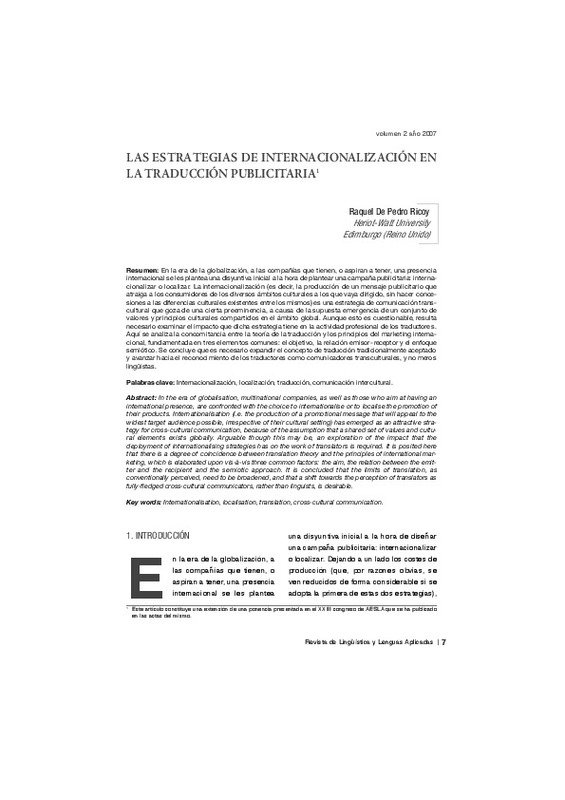JavaScript is disabled for your browser. Some features of this site may not work without it.
Buscar en RiuNet
Listar
Mi cuenta
Estadísticas
Ayuda RiuNet
Admin. UPV
LAS ESTRATEGIAS DE INTERNACIONALIZACIÓN EN LA TRADUCCIÓN PUBLICITARIA
Mostrar el registro sencillo del ítem
Ficheros en el ítem
| dc.contributor.author | Pedro Ricoy, Raquel De
|
|
| dc.date.accessioned | 2011-03-31T13:22:28Z | |
| dc.date.available | 2011-03-31T13:22:28Z | |
| dc.date.issued | 2007 | |
| dc.identifier.issn | 1886-2438 | |
| dc.identifier.uri | http://hdl.handle.net/10251/10623 | |
| dc.description.abstract | [EN] In the era of globalisation, multinational companies, as well as those who aim at having an i n t e rnational presence, are confronted with the choice to internationalise or to localise the promotion of their products. Internationalisation (i.e. the production of a promotional message that will appeal to the widest target audience possible, irrespective of their cultural setting) has emerged as an attractive strategy for cross-cultural communication, because of the assumption that a shared set of values and cultural elements exists globally. Arguable though this may be, an exploration of the impact that the deployment of internationalising strategies has on the work of translators is re q u i red. It is posited here that there is a degree of coincidence between translation theory and the principles of international marketing, which is elaborated upon vis-à-vis three common factors: the aim, the relation between the emitter and the recipient and the semiotic approach. It is concluded that the limits of translation, as conventionally perceived, need to be broadened, and that a shift towards the perception of translators as fully-fledged cross-cultural communicators, rather than linguists, is desirable. | es_ES |
| dc.description.abstract | [ES] En la era de la globalización, a las compañías que tienen, o aspiran a tener, una presencia internacional se les plantea una disyuntiva inicial a la hora de plantear una campaña publicitaria: internacionalizar o localizar. La internacionalización (es decir, la producción de un mensaje publicitario que atraiga a los consumidores de los diversos ámbitos culturales a los que vaya dirigido, sin hacer concesiones a las diferencias culturales existentes entre los mismos) es una estrategia de comunicación transcultural que goza de una cierta preeminencia, a causa de la supuesta emergencia de un conjunto de valores y principios culturales compartidos en el ámbito global. Aunque esto es cuestionable, resulta necesario examinar el impacto que dicha estrategia tiene en la actividad profesional de los traductores . Aquí se analiza la concomitancia entre la teoría de la traducción y los principios del marketing intern acional, fundamentada en tres elementos comunes: el objetivo, la relación emisor- receptor y el enfoque semiótico. Se concluye que es necesario expandir el concepto de traducción tradicionalmente aceptado y avanzar hacia el reconocimiento de los traductores como comunicadores transculturales, y no meros lingüistas. | |
| dc.language | Español | es_ES |
| dc.publisher | Editorial Universitat Politècnica de València | es_ES |
| dc.relation.ispartof | Revista de Lingüística y Lenguas Aplicadas | |
| dc.rights | Reserva de todos los derechos | es_ES |
| dc.subject | Traducción | es_ES |
| dc.subject | Comunicación intercultural | es_ES |
| dc.title | LAS ESTRATEGIAS DE INTERNACIONALIZACIÓN EN LA TRADUCCIÓN PUBLICITARIA | es_ES |
| dc.type | Artículo | es_ES |
| dc.date.updated | 2011-03-31T12:32:54Z | |
| dc.identifier.doi | 10.4995/rlyla.2007.697 | |
| dc.rights.accessRights | Abierto | es_ES |
| dc.description.bibliographicCitation | Pedro Ricoy, RD. (2007). LAS ESTRATEGIAS DE INTERNACIONALIZACIÓN EN LA TRADUCCIÓN PUBLICITARIA. Revista de Lingüística y Lenguas Aplicadas. 2:7-16. https://doi.org/10.4995/rlyla.2007.697 | es_ES |
| dc.description.accrualMethod | SWORD | es_ES |
| dc.relation.publisherversion | https://doi.org/10.4995/rlyla.2007.697 | |
| dc.description.upvformatpinicio | 7 | |
| dc.description.upvformatpfin | 16 | |
| dc.description.volume | 2 | |
| dc.identifier.eissn | 1886-6298 | es_ES |
| dc.description.references | Adab, B. (2002). "The Translation of Advertising: A Framework for Evaluation", B a b e l4 7 - 2:133-155. | es_ES |
| dc.description.references | Austermühl, Frank. (2001). Electronic Tools for Translators. Manchester: St. Jerome. | es_ES |
| dc.description.references | Bassnett, S. (1993).Comparative Literature. A Critical Introduction. Oxford UK & Cambridge USA: Blackwell. | es_ES |
| dc.description.references | Bell, A. (1984). "Language style as audience design", Language in Society13-2: 145-204. | es_ES |
| dc.description.references | Boutlis, P. (2000). "A Theory of Postmodern Advertising", International Journal of Advertising19-1: 3-23. | es_ES |
| dc.description.references | de Pedro, R. (1996). "Beyond the Words: The Translation of Television Adverts", Babel 42 -1:27-45. | es_ES |
| dc.description.references | Edge. (2002). "Ex-box?": 46-53. | es_ES |
| dc.description.references | Even-Zohar, I. (1990). Polysystem Studies. Durham: Duke University Press. | es_ES |
| dc.description.references | Kaynak, E. y A. Kara. (2001). "An Examination of the Relationship among Consumer Lifestyles, Ethnocentrism, Knowledge Structures, Attitudes and Behavioural Tendencies: A Comparative Study of Two CIS States", International Journal of Advertising 20-4:455-482. https://doi.org/10.1080/02650487.2001.11104906 | es_ES |
| dc.description.references | Nord,C.(1989)."Textanalyse und Übersetzungsauftrag" en F.G. Königs (ed), Überset-zungswissenschaft und Fremdsprachenunterricht. Neue Beiträge zu einem alten Thema. Munich: Goethe-Institut: 95-119. | es_ES |
| dc.description.references | Reiss, K. y H.J. Vermeer. (1984). Grundlegung einer allgemeinen Translationstheorie. Tübingen: Niemeyer. https://doi.org/10.1515/9783111351919 | es_ES |
| dc.description.references | Rosenberg, J. (2000). The Follies of Globalisation Theory. Londres / Nueva York: Verso. | es_ES |
| dc.description.references | Toury, G. (1995). Descriptive Translation Studies and Beyond. Amsterdam: John Benjamins. https://doi.org/10.1075/btl.4 | es_ES |
| dc.description.references | Valdés Rodríguez, C. (2004). La traducción publicitaria: comunicación y cultura. Valencia: Universitat de València. | es_ES |
| dc.description.references | Venuti, L. (1995). The Translator's Invisibility. London: Routledge. https://doi.org/10.4324/9780203360064 | es_ES |








